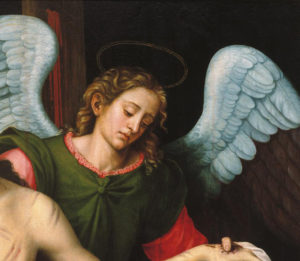This week, September transitions to October. An ending and a beginning in the midst of autumn and it is a week overseen by shining beings, for these are days traditionally given to angels: In three days’ time, on October the 2nd, we celebrate the Feast of the Guardian Angels, and today, the 29th of September, brings the Feast of St. Michael the Archangel––a day better known as Michaelmas.
The one that comes later is more personal, a day set aside to honor our personal guardian angels. It is a very old tradition, one that dates to the Fourth Century, when folks began setting up altars in their homes on the feast in honor of their angelic protectors. The one that comes today––Michaelmas (pronounced mick-il-mus)––begins with Michael the Archangel but has come to honor angels in general. Michaelmas is traditionally a night for a dinner of roast goose, and afterward, roasted nuts. But it is the humble blackberry that is most traditional for this day: In Scotland, there are Struan Micheil, Michaelmas bannocks, somewhat like a scone but more of a flatbread, cut into wedges, comprised of equal parts oats, barley, and rye, and traditionally made without the use of metal: wooden fork, wooden or ceramic bowl, baking stone. The bannocks are served with blackberries or blackberry jam, for it was Michael the Archangel who battled Satan, the fallen angel, and when Satan fell to Earth, it was in a bramble patch––a blackberry patch––that he landed. Legend has it that each year after Michaelmas, Satan returns to curse and spit upon the brambles that he landed upon, which is not so surprising: Bramble patches are thorny and painful. You’d probably curse and spit upon them, too, if you fell into a bramble patch. Be that as it may, many people will not eat blackberries after Michaelmas for this reason, and so they’ll eat their fill of the plump, juicy berries today.
My favorite part of this particular day, though, is that it is a chance to recite a litany of names––while Michaelmas is another old feast that comes out of the Catholic church, various traditions will honor today Michael as well as his companions, Gabriel and Raphael. Still others will include Uriel, Raguel, Ramiel, and Sariel. I love these names; they roll past my lips in an ancient and mysterious tongue, and the further down the roster we go, the more mysterious the names become. To speak them is to cross a fascinating linguistic bridge to the past. The “-el” suffix of these angelic names is Sumerian in origin, signifying “brightness” or “shining,” names that in their true form would be Micha-el, Gabri-el, Rapha-el, Uri-el, Ragu-el, Rami-el, Sari-el. The list goes on: Camael, Jophiel, Zadkiel, and Anael, Simiel and Oriphiel, then on to Metatron, Israfil, and Malak al-Maut. It is a walk across an ancient bridge of etymology that connects to the Akkadian ilu (radiant one), Babylonian ell (shining one), Old Welsch ellu (shining being), Old Irish aillil (shining), Anglo-Saxon aelf (radiant being), and English elf (shining being).
CALLING ALL ANGELS
Please join me tomorrow, 3 PM Eastern on Wednesday September 30, for Book Arts 101: Home Edition… it’s Episode 23 and this one is titled “Calling all Angels” and it is all about these angelic things, and more. Watch on Facebook Live and if you can’t make it at 3, worry not, video is posted immediately after the broadcast at our Facebook page.
A reminder, too, about our new embroidered protective face masks from Chiapas. Straight to the point: they are made by an extended family there whose traditional income source (tourism to Mexico) vanished with the pandemic. But in August, they began making face masks and they are just exquisite and you’ll love them and we love the fact that every purchase directly supports the family. They appreciate every order, and so do we. Click here to see them and to order… and yes, there are specials and free domestic shipping offers! (International orders? Write me at <mail@conviviobookworks.com> and we’ll see what we can do to get you a great price for shipping, too.)
Image: Detail from “Christ in the Arms of Two Angels” by Juan de Juanes. Oil on panel, c. 16th century. [Public domain] via Wikimedia Commons.
